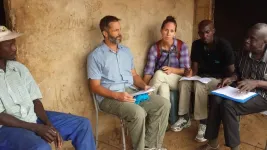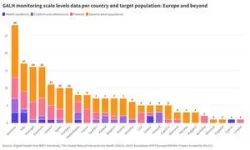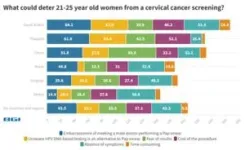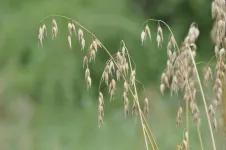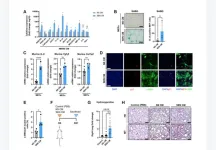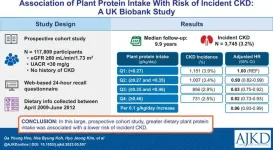(Press-News.org) It’s an elegant solution: Remove the habitat of a parasite-carrying aquatic snail and reduce the level of infection in the local community; all while generating more feed and compost for local farmers.
A collaboration of scientists from the United States and Senegal focused on doing just that by removing overgrown aquatic vegetation from areas upstream of the Diama Dam in northeastern Senegal. In doing so, they generated positive impacts to the local communities’ health and economies.
“It is rare and gratifying when we can find a potential win-win solution to both human health and livelihoods,” said UC Santa Barbara geography professor David López-Carr, a co-author of a paper that appears in the journal Nature. In it, the researchers provide proof for a hypothesis that agricultural activities, including the use of fertilizers, contribute to parasitic infections by fueling the growth of aquatic vegetation. “The results suggest a simple solution to positively impact society at the intersections of health, society and economy of northern Senegal, with implications for the over 700 million people globally in schistosomiasis endemic areas.”
Since the construction of the Diama Dam in 1986, local farmers have had better access to fresh water to irrigate their fields. However, the presence of the new infrastructure also has increased the prevalence of the schistosoma parasite, a tiny freshwater flatworm commonly found in Africa, South America and Southeast Asia. Nearly 250 million people around the world are estimated to be infected with this parasite.
As far as tropical diseases go, schistosomiasis (also known as bilharzia or snail fever) isn’t immediately fatal or even transmissible between people. But in the long term, the condition is debilitating.
“The disease is most prevalent in poor communities lacking potable water and adequate sanitation,” said López-Carr, an anthropogeographer who specializes in human-environment dynamics in the developing world. Adult worms take up residence in blood vessels and lay eggs in tissue, causing reactions and generally wreaking havoc on organs. Long-term effects include increased risk for cancer and infertility, and those infected are less able to work and go to school, keeping them in the cycle of poverty. “Poor farmers can lose up to half of their yields due to infection,” he said.
Health agencies and organizations have been fighting these infections with drugs that work well, however, the medicine does not prevent reinfection, which can happen as soon as the individual encounters contaminated water. Previous research has also focused on using the snails’ natural predators — prawns — which were cut off by the dam.
In their effort to get ahead of the disease, the collaboration took a close look at the habitat that supports the worms’ intermediate host, a small snail that lives in the Senegal River and its tributaries. They found that a common aquatic plant called Ceratophyllum demersum — also known as hornwort — can hold up to 99% of these snails, with which they have a mutualistic relationship.
Exacerbated by fertilizer runoff from agricultural operations farther upstream, c. demersum and other aquatic plants tend to proliferate in local waterways, which impedes access for daily activities such as cooking, irrigation and washing clothes.
For their experiment, the researchers conducted a three-year randomized control trial in 16 communities, to see if and how much nuisance vegetation removal in about half of the communities would affect the presence of the snails. They measured baseline infection rates, administered antiparasitic drugs, removed the vegetation and then measured reinfection rates in more than 1,400 schoolchildren. In total, the research teams took out an estimated 430 metric tons (wet) of aquatic vegetation from water access points.
“In our randomized controlled trial, control sites — places where we didn’t remove submerged vegetation from water access points — had 124% higher intestinal schistosoma reinfection rates,” López-Carr said. In addition to lowered infection rates where they removed the vegetation, the researchers found that the removed material could be used to feed livestock, or turned into compost for growing crops, lowering costs dramatically and increasing yields for local farmers. In this way, according to López-Carr “the approach yielded an economic incentive to remove nuisance vegetation from waterways and return nutrients from aquatic plants back to the soil and for livestock feed with the promise of severing poverty-disease traps while lowering infectious burden at the same time.”
“A broader benefit is the hope that this example can set for enhancing win-win planetary health research and solutions that improve livelihoods while also reducing infectious morbidity and mortality,” he added.
Having conducted these trials, the researchers hope that this study is implemented elsewhere in other similar regions to replicate the same kind of health and economic outcomes.
And, it might not be just a solution for developing countries. “Perhaps vegetation growth resulting from excess nutrients could also be used as livestock feed in more developed countries as well,” López-Carr said.
END
Nuisance vegetation removal in Senegalese waterways reduces the overall prevalence of parasitic infections and increases local food production
2023-08-01
ELSE PRESS RELEASES FROM THIS DATE:
The Lancet: New study reveals global anemia cases remain persistently high among women and children. Anemia rates decline for men.
2023-08-01
**Embargo: 23.30 [UK time] / 6.30pm [ET] Monday, July 31, 2023**
Peer-reviewed
The Lancet: New study reveals global anemia cases remain ...
Genome data rewrite the story of oat domestication in China
2023-08-01
Oat is among the top ten cereal crop species in terms of global production. It can adapt to different climates, and farmers can grow it successfully even in harsh environments where other crops such as rice and corn fail. However, not all oat plants are the same. Based on their grains, two major oak varieties can easily be distinguished: hulled, grains that are covered in a non-edible husk, and naked, grains that have a soft outer casing that easily separates from the edible grain during threshing. To gain information on the origins of these different varieties, researchers in China have sequenced the ...
Holding Trump accountable will not threaten American democracy
2023-08-01
With a Fulton County indictment of former President Donald Trump possible at any time, law enforcement in Atlanta is bracing for potential violence, with orange barricades restricting access to the entrance of the county courthouse.
With the anticipation of each new indictment has come threats of violence, decrease in trust in American justice and calls for retribution against the government. Just how concerned should Americans be that we may face another January 6th-type incident?
New data from the Polarization ...
Modifications to amino acids in sperm could be behind infertility
2023-07-31
Sperm play a critical role in the creation of new life, delivering essentially half of the genetic material required.
The success of this process relies on the generation of a developmentally competent sperm cell, which is often determined by shape. Indeed, during in vitro fertilization, the “best-looking” sperm is selected to fertilize an egg.
However, how this optimal shape translates to proper sperm function is difficult to assess because of many confounding factors.
Researchers at the University of Michigan are now delving into the molecular-level details of sperm formation, with a particular focus on how abnormalities in ...
Harnessing the power of light: Advancements in photonic memory for faster optical computing
2023-07-31
Technological advancements like autonomous driving and computer vision are driving a surge in demand for computational power. Optical computing, with its high throughput, energy efficiency, and low latency, has garnered considerable attention from academia and industry. However, current optical computing chips face limitations in power consumption and size, which hinders the scalability of optical computing networks.
Thanks to the rise of nonvolatile integrated photonics, optical computing devices can achieve in-memory computing while operating with zero static power consumption. Phase-change materials (PCMs) have emerged as promising candidates for achieving photonic memory and nonvolatile ...
Study raises possibility of immunotherapy treatment for ALS
2023-07-31
New research reveals a type of monoclonal antibody already tested in certain forms of cancer may be a promising treatment in stopping the progression of amyotrophic lateral sclerosis, or ALS, a fatal neurodegenerative disease.
The study, led by scientists at Oregon Health & Science University, published today in the Proceedings of the National Academy of Sciences.
The study, involving a mouse model and confirmed in the tissue of human brains affected by ALS and donated after death, revealed for the first time that modulating immune cells can slow the progression of the disease. Previous research suggested a role for immune cells in ALS, but researchers this time used a high-throughput ...
Multi-level international study explores anxiety, concerns of families with a child with a neurodevelopmental condition during the COVID-19 pandemic
2023-07-31
A peer-reviewed study published in the Journal of Global Health analyzed data from more than 6,600 families with a child with a neurodevelopmental condition (NDC)—autism, attention-deficit/hyperactivity disorder, developmental language disorder, Down syndrome, Williams syndrome, and intellectual disability—from 70 countries, including the United States.
The study was led by Andrea Samson, associate professor of psychology at UniDistance Suisse and University of Fribourg, Switzerland, and Jo Van Herwegen, professor in developmental psychology and education at University College London’s ...
Human senescent fibroblasts cause lung fibrosis in mice
2023-07-31
“These observations support that accumulation of senescent cells may contribute to fibrotic lung disease [...]”
BUFFALO, NY- July 31, 2023 – A new research paper was published on the cover of Aging (listed by MEDLINE/PubMed as "Aging (Albany NY)" and "Aging-US" by Web of Science) Volume 15, Issue 14, entitled, “Human senescent fibroblasts trigger progressive lung fibrosis in mice.”
Cell senescence has recently emerged as a potentially relevant pathogenic mechanism in fibrosing interstitial lung diseases (f-ILDs), particularly in idiopathic pulmonary fibrosis. In a new study, researchers Fernanda Hernandez-Gonzalez, ...
Plant-based protein intake may reduce kidney disease risk
2023-07-31
Plant-based diets confer various health benefits, including lowering the risk of cardiovascular disease and certain cancers. However, the relationship between plant protein intake and the risk of chronic kidney disease (CKD) remains unclear. This study led by Ga Young Heo aimed to investigate the association between plant protein intake and the development of CKD. Using the UK biobank study data, the researchers found that participants with a higher plant protein intake had a lower risk of developing CKD. This finding suggests that a higher dietary intake of plant-based protein may be beneficial for kidney health and provide insight into ...
Researchers identify two new subtypes of HPV-associated head and neck cancers
2023-07-31
CHAPEL HILL, N.C. – Cases of human papillomavirus (HPV)-associated cancers of the head and neck, known as head and neck squamous cell carcinoma (HNSCC), are rapidly increasing throughout the United States. Unfortunately, relatively little is known about the factors that contribute to these tumors and what makes some tumors more aggressive and treatment-resistant than others.
To determine why some patients respond better to radiation therapy than others, researchers in UNC School of Medicine’s Department of Otolaryngology/Head and Neck ...
